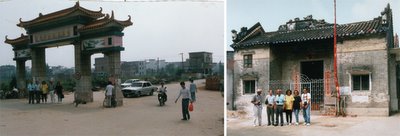7. Loo Jow, now
 (1a) Modern map of the Shunde region, highlighting the location of Lecong City, just south of Foshan (adapted from Lecong International Exhibition Center website); (1b) modern map highlighting the location of Loo Jow (Luzhou), home of Dong Hin, and Ping Po (Pingbu), ancestral village of Mok Shee.
(1a) Modern map of the Shunde region, highlighting the location of Lecong City, just south of Foshan (adapted from Lecong International Exhibition Center website); (1b) modern map highlighting the location of Loo Jow (Luzhou), home of Dong Hin, and Ping Po (Pingbu), ancestral village of Mok Shee.
Here is a description of Lecong from a New York Times article from Januray 2004:
"The main street of Lecong is a five-mile Vegas-like stretch of gaudy showrooms and exhibition centers, factories and cavernous warehouses, leather suppliers and timber yards, all dedicated to making and selling furniture.
Until a decade ago, this town, in
Much of the growth has come from exports. In the last eight years,
Another illustration of the pace of change comes first-hand from Ron and Judy. In 1997, Richard, Joe, Diana, Dan, Bernice, Ron, and Janet visited Loo Jow, guided by a distant cousin from
******
Ron (1997):
"It was a Sunday afternoon in 1997 when we arrived at Loo Jow after a 30 minute taxi ride from the ferry terminal. A relative of our
At the entrance is the town square with a huge gateway. There were twogeneral stores and an area where a farmers market does business in the morning. The streets and alleys in the village are narrow and restricted to pedestrians, bicycles, and motor cycles. The buildings, compounds are mostly of brick and stone construction. They are very old and in disrepair. This village probably [hasn't] changed too much for over a hundred years - it is still quite primitive.

 (2) Reading from right to left, the gateway sign reads (in Pinyin, the standardized form of Mandarin transliteration): "Lù Zhōu Cūn Zé Pŭ Dà Dào"; this very roughly translates as the "boulevard (Dà Dào) by the large canal (Zé Pŭ) to the village (Cūn) in the land filled (Zhōu) with egrets (Lù)"; the gate and sign are no longer there, torn down as part of a modernization campaign (photos Ron Dong)
(2) Reading from right to left, the gateway sign reads (in Pinyin, the standardized form of Mandarin transliteration): "Lù Zhōu Cūn Zé Pŭ Dà Dào"; this very roughly translates as the "boulevard (Dà Dào) by the large canal (Zé Pŭ) to the village (Cūn) in the land filled (Zhōu) with egrets (Lù)"; the gate and sign are no longer there, torn down as part of a modernization campaign (photos Ron Dong)
Because it was a Sunday all of the public facilities were closed so we were not able to do any family history research. We wandered around for about an hour and observed a stone staircase leading down to a water inlet and saw a woman doing the laundry by hand. In a small factory there were two young girls working on machinery making metal door hinges.
Traffic in the village was minimal except for an occasional cyclist. There were no cars in the village which was nice but one can easily get lost in the maze of narrow paths, alleys, and streets. Of course, we got lost and had to ask two young boys for directions back to the entrance.
We were lucky to have visited Loo Jow before modernization completely takes over as already there are signs of demolition and constructions everywhere. The highway that runs by is heavily used and congested. Will Loo Jow be saved?"
******
Judy (December, 2005):
"LeCong: rapid modernization, busy with vehicles and workers moving at a quick pace in the furniture manufacuring and marketing business.
LooJow: very serene in comparison to Lecong. It was a warm sunny day and walking down the clean lane was a cozy feeling. One house had red banners and double happiness pasted around the doorway indicating a marriage in that house; definitely a good omen.
I wanted to sit alone by the creek under the old tree to quietly soak up the surroundings, gentle flow of the creek, warm sun and lack of automobile and factory sounds to try visualizing what life might have been like on a busy wash day at the creek. Whose family was downstream? Whose [family] was across the foot bridge?
[The] Ancestor house opened [my] mind to [imagine] what it would have been like to be with family within the four walls.
(1a) A water well in Loo Jow that may have been used by the Dong clan; (1b) the alleyway leading to the site of the Dong family compound (photos Judy Dong)
I was struck by the contrast of the modern three story homes and the anticipated increase in student enrollment at the new preschool and elementary school rise in number of students. The student id badges that monitor student attendance was something I would love to have at




0 Comments:
Post a Comment
<< Home